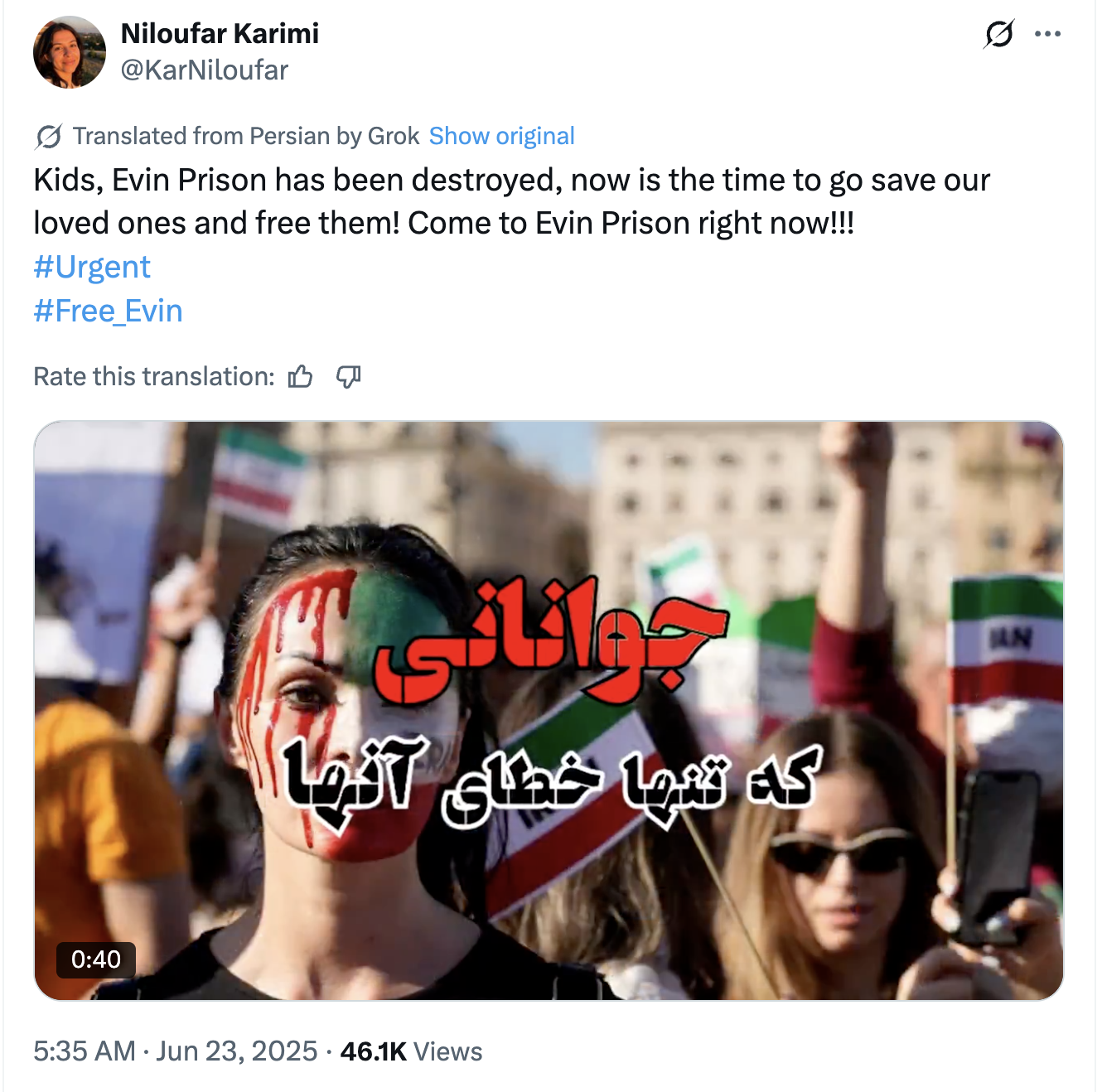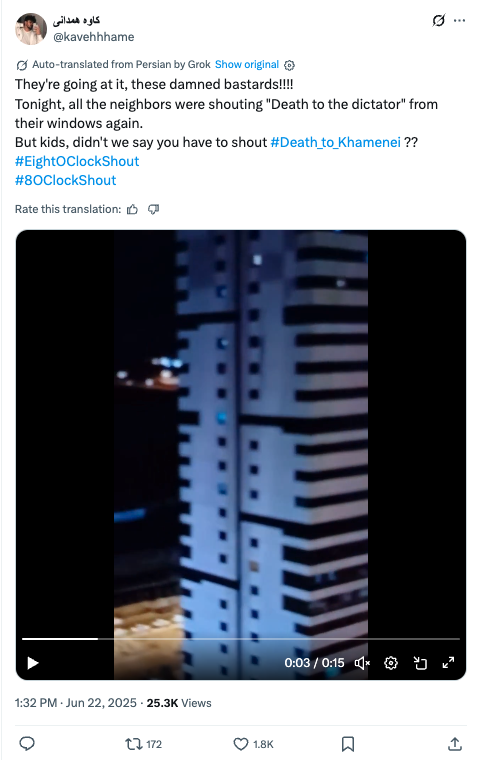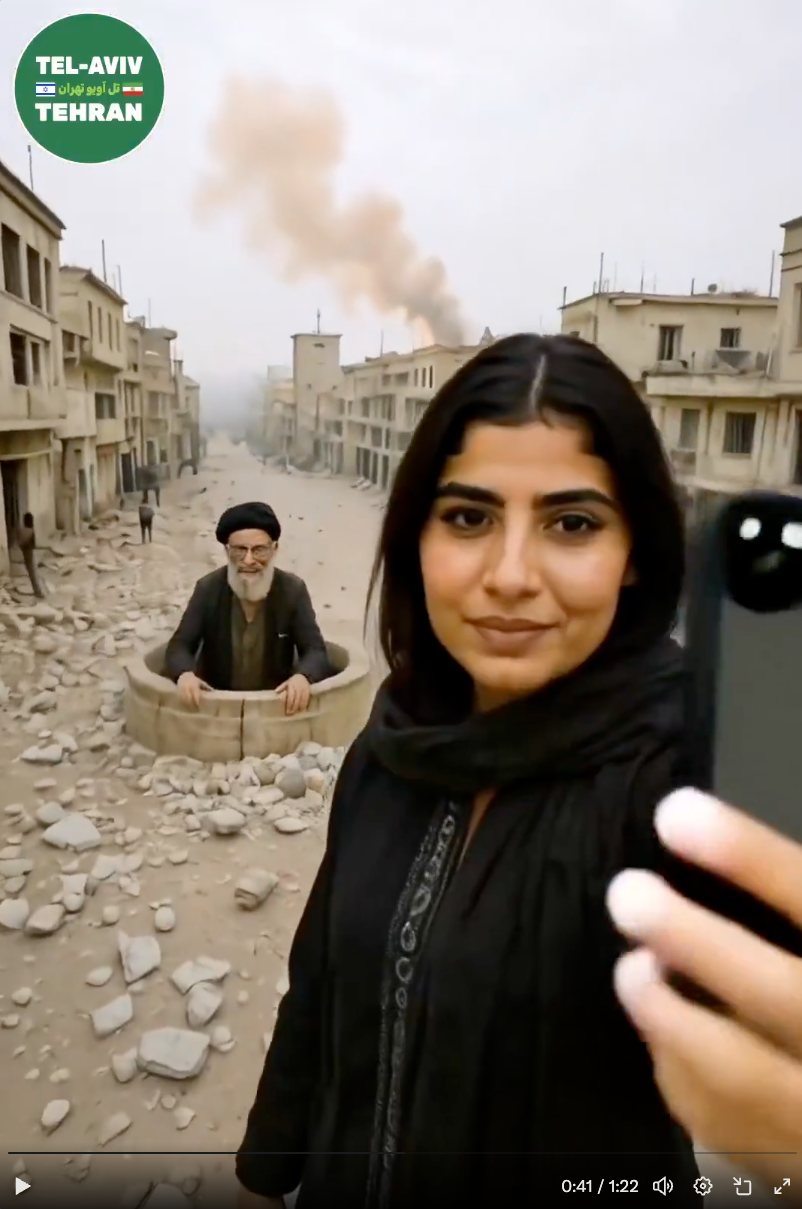Key Findings
- A coordinated network of more than 50 inauthentic X profiles is conducting an AI-enabled influence operation. The network, which we refer to as “PRISONBREAK,” is spreading narratives inciting Iranian audiences to revolt against the Islamic Republic of Iran.
- While the network was created in 2023, almost all of its activity was conducted starting in January 2025, and continues to the present day.
- The profiles’ activity appears to have been synchronized, at least in part, with the military campaign that the Israel Defense Forces conducted against Iranian targets in June 2025.
- While organic engagement with PRISONBREAK’s content appears to be limited, some of the posts achieved tens of thousands of views. The operation seeded such posts to large public communities on X, and possibly also paid for their promotion.
- After systematically reviewing alternative explanations, we assess that the hypothesis most consistent with the available evidence is that an unidentified agency of the Israeli government, or a sub-contractor working under its close supervision, is directly conducting the operation.
Timeline
Background
Influence Operations in the Geopolitical Contest Between Israel and Iran
In the geopolitical and ideological competition between the Islamic Republic of Iran and its international and regional adversaries, control over and strategic manipulation of the information environment has always played a key role.
While relatively little is known about influence operations (IOs) run directly by the Israeli government, military, or intelligence services, both independent press and social media platforms’ investigations have previously exposed several highly sophisticated Israeli covert influence operators, and their alleged connections to the country’s government. Two notable examples are Team Jorge and Archimedes Group. Both companies offered their services to a wide array of clients globally, used advanced technologies to build and conduct their covert campaigns, and advertised existing or prior connections to the Israeli intelligence community.
For its part, the Islamic Republic considers media and information technologies as a battleground of regime survival. It has muzzled the press, disrupted satellite reception, and developed one of the most sophisticated systems of internet censorship worldwide. In its attempts to control information and shape narratives beyond borders, the Islamic Republic has also produced IOs targeting both the Iranian diaspora and international audiences, and relied on methods of transnational repression to silence critics abroad.
Prior Citizen Lab research has uncovered Iranian disinformation efforts. In this investigation, we focus on the “other side” of the geopolitical competition: namely, an IO effort we assess as most likely undertaken by an entity of the Israeli government or a private subcontractor working closely with it.
The “Twelve-Day War”
The central focus of the IO examined in this report is the “Twelve-Day War” which began on June 13, 2025, when Israel launched a major military attack against Iran, striking military sites, nuclear facilities, and infrastructure installations. The war was a culmination of a decade-long tension over Iran’s nuclear program, which Israel views as an existential threat. In highly targeted operations, Israel also killed senior commanders in Iran’s military and security apparatus, as well as scientists associated with the nuclear program. Iran retaliated with ballistic missiles and drones.
While the stated objective of Israel’s attack was to degrade Iranian nuclear and missile capabilities, the airstrikes expanded to other critical infrastructure, including oil industry facilities and the national broadcaster in Tehran. Speculation that Israel was aiming for regime change was further fuelled by Prime Minister Netanyahu’s call to the Iranian people to stand up against their oppressive regime. The United States entered the conflict on June 22, striking three nuclear facilities in Iran. After Iran’s limited retaliation against a U.S. base in Qatar, a ceasefire took hold on June 24, ending the 12-day conflict.
The day before the ceasefire, on June 23, the Israel Defense Forces (IDF) carried out multiple air strikes on Evin Prison in Tehran. The detention facility is notorious for the mistreatment of political prisoners with frequent reports of solitary confinement and torture. Among the detainees are dual and foreign nationals held for leverage in the regime’s “hostage diplomacy.” The daytime attack caused severe damage and disruption within the facility, raising concern for the safety of inmates, among them high-profile dissidents. According to Iranian authorities 80 people were killed in the strike. A group of prominent Iranian human rights defenders, including Nobel Peace Prize laureate Narges Mohammadi, as well as international human rights organizations condemned the attack as a serious violation of international humanitarian law.
Later that day, the Israeli military confirmed in a press briefing that they had carried out a “targeted strike” on Evin Prison as a “symbol of oppression for the Iranian people.” Israeli government officials also mentioned the strike in social media posts. Foreign Minister Gideon Saar described the attack as a response to Iran’s targeting of civilians and tied it to a call for liberation.
The IO examined in this report synchronized its activities closely with the airstrikes on Evin Prison to advance a narrative of regime change in Iran.
Research Methodology
This network was initially detected and referred to us by Darren Linvill, co-director of the Watt Family Innovation Center Media Forensics Hub at Clemson University. Linvill and his team had identified an initial set of 37 X accounts presenting key similarities:
- Posting during the same hours of the day.
- Using the same client (Twitter Web App, a less common client for X than its mobile apps).
- Adopting a stolen profile picture, or pictures, that would not identify the person being depicted and offering no identifying information in biography.
- Disseminating the same content, including identical strings of hashtags.
- All profiles were created in 2023, and almost all remained silent until January 2025.
As we set out to research the network, we conducted our investigation of the network by deploying an array of open-source data collection techniques and using analytical methods to examine metadata and activity patterns. We summarize these techniques and methods below.
Data Collection
For qualitative research – for example, the review of content or metadata patterns – we primarily used manual collection techniques. These included:
- The collection of publicly available metadata for the X accounts, such as the profile’s creation date, bio, posted links, followers/following, handles/user IDs, profile and cover pictures, and (partially obfuscated) associated email addresses
- The collection and preservation of content – including X posts and the associated media (pictures, videos)
- The enumeration of the URLs posted by the accounts, as well as the extraction of the related web domains.
For quantitative research – the collection and subsequent analysis of data on the accounts at scale – we benefited from the Watt Family Innovation Center Media Forensics Hub’s X data access through an authorized third-party platform.
Analysis
A non-exhaustive list of analytical methods that we have utilized to develop this research is shown below.
- Datasets: to surface patterns in content and/or metadata. For example, hashtags; shared URLs; or posting times.
- Social network analysis (SNA) tools: to analyze the relationships between accounts or other digital assets.
Additionally, we deployed tools and methods – both manual and software-based – to assess the likelihood of individual pieces of content as being generated through the use of artificial intelligence (AI). These included, but were not limited to:
- Identification of well-known AI artifacts in body parts (hair, fingers, eyes movement for videos)
- Identification of botched rendering of static content (i.e. distorted human figures) or dynamic content (i.e. unrealistic movement of individuals or crowds in the backgrounds of videos)
- Analysis of the looping of video or audio tracks in dynamic content
- Use of open-source online tools assessing content for potential AI generation (i.e. Image Whisperer, Hive).
A “Kinetic” Influence Operation: the Evin Prison Bombing
The influence operation described in this report was initially identified through the interactions by a number of X accounts with what appeared to be a highly sophisticated deception attempt: an AI-generated video of the Evin Prison bombing. The deepfake video was thought to be real and republished by multiple international news outlets.
What follows is a description of this activity, as well as its timeline:
- According to public reports, the prison was hit multiple times between 11 a.m. and 12 p.m., Tehran local time. Human Rights Watch “confirmed, based on satellite imagery, thermal anomaly data, accounts of informed sources, and first online reports and videos, that the Israeli strikes on Evin Prison took place on June 23 between 11:17 a.m. and 12:18 p.m.”
- The first reference to an explosion at Evin Prison that we identified as published by PRISONBREAK was posted at 11:52 a.m., Tehran time. A confirmed PRISONBREAK account – @kavehhhame – posted the following. The hashtags translate to: “#8_o’clock_cry #We_don’t_forget”. We will return to the significance of the first hashtag – #8_o’clock_cry – later in this report.

Figure 1. Screenshot from a post made at 11:52 a.m. (Tehran time) on June 23, 2025 by @kavehhhame. This was the first post by a confirmed account from the PRISONBREAK network announcing the bombing of the Evin Prison by the IDF. - At 12:05 p.m. (Tehran time), when the strikes were reportedly still underway, another confirmed PRISONBREAK account – @KarNiloufar, the oldest account in the network – published a post including a video of the alleged moment of the strike on the prison’s entrance.

4. The video was later flagged as “fabricated” by BBC Persian. However, it did initially trick the press into republishing it as real.
-
-
- The exact timing of the video’s posting, while the bombing on the Evin Prison was allegedly still happening, points towards the conclusion that it was part of a premeditated and well-synchronized influence operation.
- The first organic video we could identify on X as appearing to show the aftermath of the prison’s bombing was posted at 8:36 AM UTC, one minute after the AI-generated video published by PRISONBREAK.
-
5. In the minutes following the initial posting of the video, other accounts in the PRISONBREAK network added their own contributions, claiming to have heard the sound of the explosions hitting Evin.

“Free Evin” – Inciting an Uprising
It was at this stage – beginning at 12:36 p.m. Tehran time, with the bombings having reportedly ended at 12:18 p.m. – that the network started explicitly calling for the capital city’s population to reach Evin and free the prisoners. The X accounts also posted reassuring statements such as “the attack will end now” and “the area is safe”.
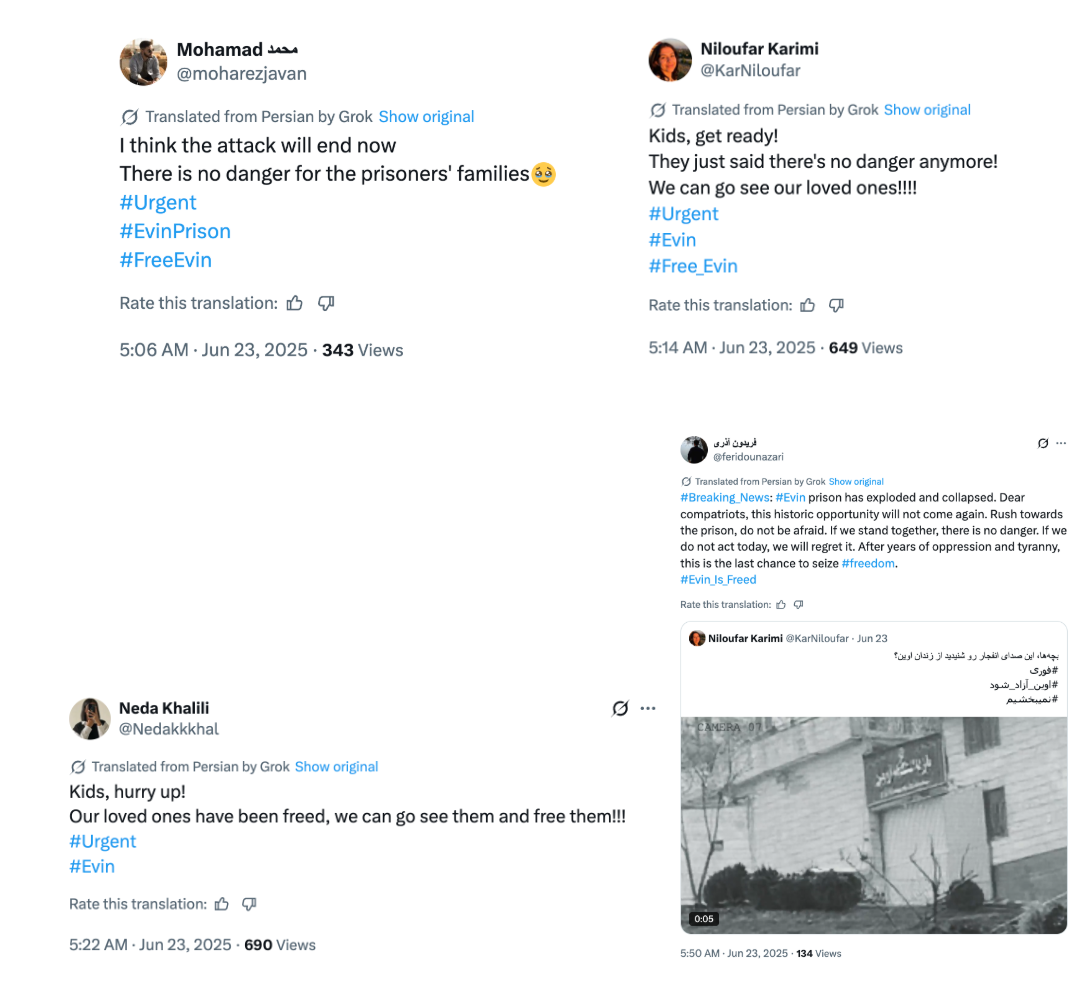
This series of posts by the PRISONBREAK network’s accounts following up to the AI-generated video and calling for people to reach the prison achieved virtually no organic engagement, and a very low amount of views, with one exception: the following post by the original video sharer, @KarNiloufar, which also included a video, managed to accrue 46,000 views and more than 3,500 likes. The PRISONBREAK network reshared the post several times.
This second video about the Evin Prison, which shows the hallmarks of professional editing and was posted within one hour from the end of the bombings further strongly suggests that the PRISONBREAK network’s operators had prior knowledge of the Israeli military action, and were prepared to coordinate with it.
A Broader Narrative: Overthrowing the Iranian Regime
The Evin Prison deepfake proved to be just one of the many pieces of content produced and amplified by the network in relation to the Twelve-Day War. Upon further analysis of the PRISONBREAK network’s posting timeline and posts content, we assess that their primary narrative was one of regime change in Iran. This appears consistent with other efforts promoting the overthrow of the Islamic Republic observed as happening in the same timeframe, attributed to Israeli government agencies, and exposed in a recent press investigation.1
In the early morning of June 13, 2025, Israel began its first bombing campaign of Iran. At the same time, we observed the PRISONBREAK network sharing images and videos of alleged civil unrest and instability in Iran. This footage included, for example, alleged Iranian military vehicles exploding. The network shared at least nine similar posts on June 13 in what appeared to be an attempt to force a public perception of instability during the initial Israeli attacks. We cannot verify the authenticity of any of the videos and it is possible that some of them were AI generated.
Two days later, the network published a series of posts highlighting the alleged economic upheaval in Iran after the first few rounds of bombings. The network told followers to head to ATMs to withdraw money, emphasized that the Islamic Republic was “stealing our money to escape with its officials,” and urged followers to rise up against the regime.
At least two of the observed posts which depict long lines of people waiting at the bank and beginning to riot show elements of AI generation. More specifically, in the example video shown below, one of the bodies blurs and becomes misshapen, suggesting the footage was AI generated.
Between June 20 and June 22, 2025, PRISONBREAK intensified its rhetoric against the Iranian regime. Under the hashtag “8 o’clock cry”, the accounts urged followers to get on their balconies at 8 p.m. each evening and shout “Death to Khamenei” (مرگ بر خامنه ای), in an attempt to capitalize on a previously established form of protest in Iran. An example of one of the posts shared by the network is shown in the figure below.
We observed at least nine videos and 23 posts shared by PRISONBREAK between June 20 to 22 of citizens allegedly participating in the “8 o‘clock cry”. The videos relating to the “8 o‘clock cry” have viewership well outside their normal rates, ranging from 20,000 to 60,000 views per post. Almost all of the videos are low quality, and do not include visible images of people shouting. Based on evidence outlined in the next section, we are able to conclude that at least some of the videos were manipulated. As we could not identify them as posted anywhere else, we conclude that the videos were likely created by the account operators.
These posts appeared to be a buildup to the Evin Prison deepfake, again pushing narratives promoting regime change in Iran. The network failed2 to drive Iranians to Evin Prison to free the political prisoners, but that did not stop their dissemination of content promoting an uprising against the country’s leadership. On June 24, Israel and Iran agreed to a ceasefire. The PRISONBREAK network then appeared to make another push to trigger unrest by questioning the ceasefire, suggesting that Iranian citizens had not received their salaries.

The PRISONBREAK operators subsequently pivoted to content related to the country’s ongoing water and energy crisis. Iran has faced a five-year drought and, in July, government officials announced that Tehran’s water supply was likely to run out in a matter of weeks. The water crisis and energy shortage made life increasingly difficult for Iranians following the Twelve-Day War. It appears that the network sought to escalate these tensions by creating and sharing content related to these issues. At the time of writing this report, PRISONBREAK is still consistently posting about both the water crisis and energy shortage, in a likely attempt to continue to escalate tensions between Iranian citizens and their government. We share two examples of this content posted by the network below.

A Synthetic Network
The Pervasive Use of AI
The Evin Prison deepfake was not an anomaly for the PRISONBREAK network’s use of AI, which appeared to be routinely used in the operation. In one occasion, the network utilized AI to distort the lyrics of a known Iranian protest song, and accompany the manipulated sound with deepfake representations of three Iranian singers.
Starting in August 2025, several confirmed network accounts shared a Youtube video3 impersonating famous Iranian singers Mehdi Yarrahi (مهدی یراحی), Toomaj Salehi (توماج صالحی), and Shervin Hajipour (شروین حاجی پور). All three singers live in Iran and have spent time in prison for their support of the 2022-23 “Woman, Life, Freedom” protest movement. In particular, Rapper Toomaj Salehi was severely tortured during his incarceration and sentenced to death in April 2024, a sentence later overturned. In the video, they allegedly perform a joint interpretation of Hajipour’s song “Baraye” which criticized social and political realities in Iran and became an anthem of the protest movement. The song in the video, however, changes the lyrics of the original, turning it into a direct call for an uprising. The main chorus in the manipulated version of the song roughly translates to “revolution for life, revolution for hope, revolution for freedom” while discussing the ongoing water crisis in Iran and other perceived or real grievances of the Iranian population.
The video and a short extract from it were the only ones posted on the YouTube channel4 “جنگ زندگی” (“The War of Life”) – which was created the same day it uploaded the song (August 13, 2025). The clip features several distinct AI failures – including a person walking backwards (who appears to be a “double” of Hajipour), crowds of people moving as a singular sliding unit, and misplacement of Toomaj Salehi’s tattoos (either duplicated or not present). We provide one example of the AI mistakes below.

At the time of writing this report, the YouTube account has 287 subscribers and the video has 466 views. We observed the PRISONBREAK network sharing the video on X one day after it was posted on YouTube, August 13, 2025, and seeding the link into Twitter Communities with over 15,000 members.
This video was just one of the many examples of PRISONBREAK spreading AI-generated imagery emphasizing the water crisis. At times, such content was of a caricatural nature. One post from the confirmed network account @feridounazari shared an AI video depicting Khamenei stealing water from a baby. Another account, @firoz_soltani, shared a video of water bottles attached to a timer meant to resemble a bomb. When the timer explodes, the caption reads “Water is our inalienable right, thirst is the end of our life.” Regardless of the post, the goal seemed to be to create and share content that deepens the political discontent in Iran and pushes the population towards revolting against the regime.
Impersonation of National and International News Outlets
Along with AI-generated content, the PRISONBREAK network impersonated legitimate news sources. For example, we identified one screenshot and two videos impersonating BBC Persian. In the caption to a screenshot of an alleged article, the original poster @KarNiloufar claimed that BBC Persian deleted it within five minutes of posting it. The headline of the article translates to “Officials flee the country; High-ranking officials leave Iran one after another”. We have verified with the BBC Persian that this article was never published by the broadcaster.
A few days after sharing the alleged article, the network posted two other videos they claimed to have been published by BBC Persian. The first video summarizes the events of the Twelve-Day War, specifically highlighting heavy traffic, gas shortages, and suggesting that Iran’s government and allies have abandoned the regime. The second video begins with a title that translates to “Special daily summary of the attack on the regime’s repressive forces,” and shares the network’s own Evin Prison deepfake, as well as other alleged explosions in Iran.
The BBC confirmed to us that they did not create or publish this content.5
We provide screenshots of the two news clips fabricated by PRISONBREAK below.

BBC Persian was not the only media outlet impersonated. We observe two other instances of media impersonation with the accounts providing links to articles from Afkar News (پايگاه خبری افکارنيوز) accompanied by a screenshot of the headline. In both instances, the links do not lead to a news article, nor were we able to locate archived versions.

Recycled or Intentionally Misleading Content
AI-generated videos were just one of the tactics employed by PRISONBREAK. We observed several instances of videos edited and shared to mislead viewers about protest activity occurring in Iran. In three of the videos shared, the accounts imply they have filmed the videos in their neighbourhood. We found that these videos were recycled content – and not authentic as the users claimed – and had been posted by accounts that appear to be unrelated to PRISONBREAK almost a week before. In addition, two of the videos were cropped and edited from the original, possibly to prevent discovery of its reuse. We additionally cannot verify the authenticity of the original videos.

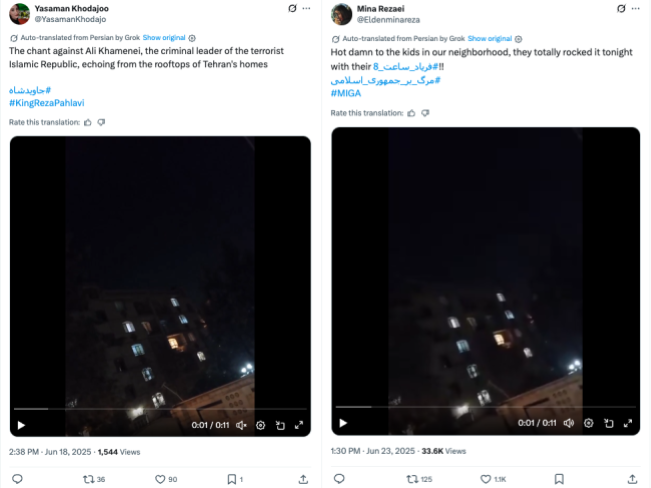
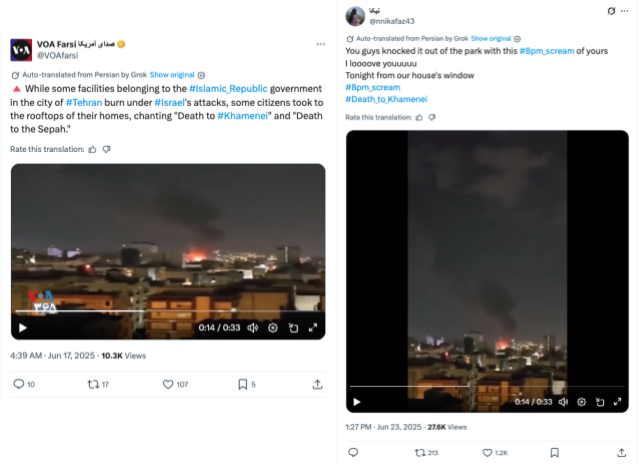
The operation not only recycled content, but possibly edited videos to fit their narrative. In the example below, the video loops several times, while the audio does not. The lack of continuity suggests that the audio has been added overtop of the video, pointing to its manipulation. The picture is also grainy, and appears to be filmed from another screen. Most notably, the audio appears to be a cut and processed version of the audio in both the VOA Farsi video and the video shared by @nnikafaz43 in the example above, suggesting that the PRISONBREAK operators have intentionally cut audio from different videos and placed it on new content.
Some edits were even less sophisticated. In the example below the “protest” audio pauses at 9 seconds, while the video continues on. At 10 seconds someone can be heard speaking in the background – presumably the creator of the video – followed by a few seconds of silence before the intended audio begins again at 12 seconds. The pause in audio, and the grainy video quality, signals that the video and audio were combined from two separate sources, and not recorded as the account claims.

Artificial Amplification
Many of the recently discovered influence operations have relatively low rates of engagement. The PRISONBREAK operators employed several tactics to help increase the rate of engagement and viewership. We outline them below.
Seeding of Content into X Communities
As described by X, Communities are “a dedicated place to connect, share, and get closer to the discussions they care about most.” They essentially consist of discussion groups that can be created and run independently by an X user.
Relative to this influence operation, Communities allowed for the network to spread their message of discontent to people who are already interested in similar topics. We observe PRISONBREAK sharing posts into communities specifically targeted at anti-Iranian regime groups including:
- Constitutionalist Association Twitter (انجمن مشروطه خواهان توییتر) with 2,900 members
- Iranian Youth Union (اتحاد جوانان ایران) with 6,700 members
- Jina Mahsa | Iran’s Revolution (ژینا مهسا | انقلاب ایران) with 5,400 members.
The network also frequently shared posts into a Persian-language “Follow Back” community with 17,600 members. This type of Community typically offers a rapid (and artificial) way for an X user to achieve a follower base by promising mutual “follows” for all its members.
By using X Communities to spread their content, PRISONBREAK artificially inflated the viewership on several posts, increasing their chances of influencing their target audience through the community members’ resharing.
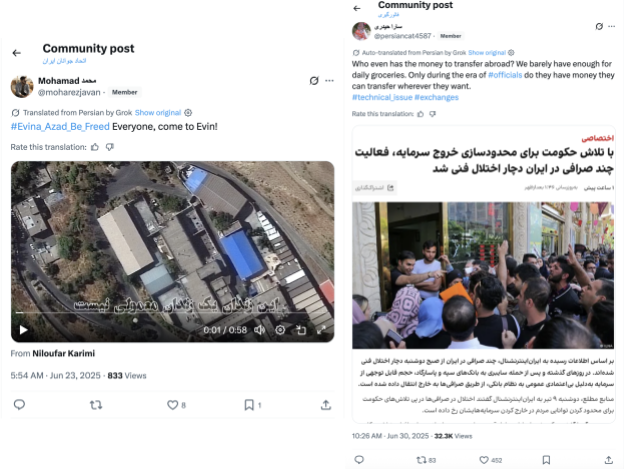
Mutual Resharing
In addition to posting in X Communities, PRISONBREAK frequently reshared the network’s own posts – especially their likely AI-generated content. This appears to be an attempt at self-amplification by the network.
At least seven different PRISONBREAK accounts reposted this video – originally posted by @Sepideh7895 – which we assess above to have been edited with repurposed audio. At least nine PRISONBREAK accounts reposted, quoted, or replied to other posts with the AI-generated photos of Khamenei in an ambulance – originally posted by @azad_leylaas, another PRISONBREAK account. This technique can be observed on nearly all of the network’s accounts, in an attempt to spread their content to as many users as possible and increase the effectiveness of their covert influence campaign.
Tagging Mainstream Media
While PRISONBREAK focused on amplifying their posts to audiences on X, they also tried to gain the attention of mainstream media. We observe several instances of PRISONBREAK accounts tagging popular news outlets like BBC Persian, VOA Farsi, and Iran International in videos shared by the network. Given the success of the Evin Prison deepfake in tricking mainstream media, tagging news accounts on other videos allegedly produced by the network demonstrates a persistent attempt to deceive the media with inauthentic Twelve-Day War content in line with the network’s narratives. We provide two examples of these efforts below.
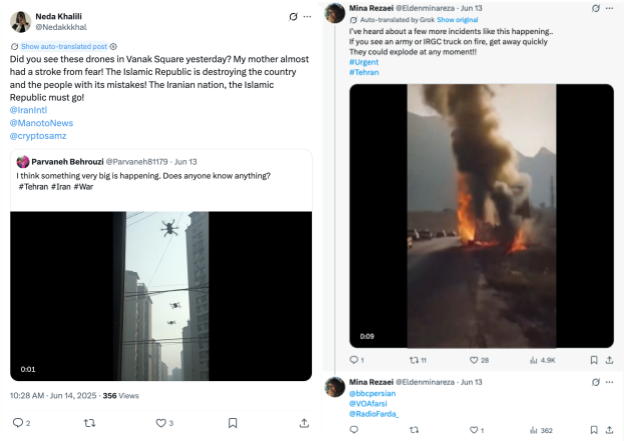
Inauthentic Accounts and Personas
We assess with high confidence that the PRISONBREAK network is both coordinated and inauthentic. It does not represent existing individuals, and was almost certainly orchestrated by a professional team, following a specific playbook.
We reach this conclusion through the analysis of a series of strong indicators that we summarize below.
Registration Email Domains
Summary: The network’s frequent use of a possibly obscure and/or proprietary email domain for account registration points strongly towards the conclusion that the accounts are closely coordinated.
Using open-source intelligence (OSINT) methods, we observed that approximately half of the X accounts in the network registered using the email domain @b********.***. Among them was also @KarNiloufar, the account who posted the AI-generated video of the Evin Prison bombing.
We were not able to conclusively identify the email domain used for the accounts. We note that it does not appear to be one of the most commonly used webmail services – i.e. Gmail, Outlook, Hotmail, or Office – and the character count does not match other popular services starting with “b”, such as for example btinternet.com.
Lifespan vs. Period of Activity
Summary: While the accounts were all created in 2023, 99.5% of their posting happened after January 2025. This strongly signals both their coordination and inauthenticity.
All confirmed accounts in this network were created between February and December 2023. However, only a handful of posts were made before the network ramped up its activity in January 2025 and in the following months.
Specifically:
- The network published only approximately 0.5% of the estimated total number of posts before 2025.
- Such posts exclusively consisted of reposts. There was no originally created content being posted.
The network came to life – in terms of its posting activity – beginning in January 2025, possibly responding to a specific directive, and in coincidence with the escalation of geopolitical tensions that eventually led to the Twelve-Day War in June 2025.

Posting Time Patterns
Summary: Posting time patterns are consistent with those of a professional, dedicated team of operators producing posts as part of a regular work day.
A review of the posting time patterns for the network – i.e. the number of posts published in total by the accounts in each hour of the day – shows that the network:
- Typically begins ramping up activity at 6 a.m. UTC (9:30 a.m. Tehran time) each day.
- Significantly escalates the volume of posts starting at 7 a.m. UTC (10:30 a.m. Tehran time).
- Begins winding down posting activity after 3 p.m. UTC (6:30 p.m. Tehran time).
- Has minimal average posting activity between 9 p.m. UTC (12:30 a.m. Tehran time) and 6 a.m. UTC (9:30 a.m. Tehran time).
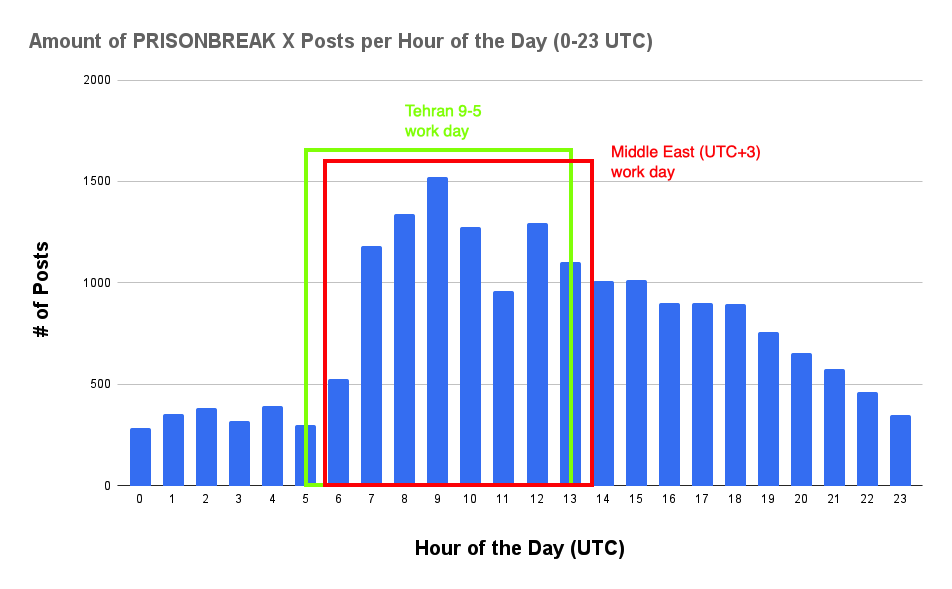
This behaviour approximately coincides with a regular work day in the Iranian timezone (Iranian Standard Time or IRST, equivalent to UTC+3:30), and even more so in UTC+3, the time zone applying to most of the Middle East (as well as Eastern Europe and parts of Eastern Africa), including Israel.
It is, however, inconsistent with an organic community of users spontaneously posting at random times of the day.
Application Version
Summary:The network’s consistent and prevalent use of X’s desktop application to post its content is more consistent with the work of a professional team than with the activity of an organic community.
We estimate that at least 75% of the posts produced by the network were posted through X’s desktop interface (formerly known as Twitter Web App). This information is visible in the network response provided when loading a given post in a web browser, using the browser’s Developer Tools or equivalent name.

Like the posting timing patterns, the almost exclusive use of the web version of X – a mobile-first platform like other social media – is consistent with a professionally run network of digital assets, where a team is assigned to operating one or more of the accounts through dedicated workstations. Similar behaviour has been previously used as a signal to identify IOs.
Profile Photos
Summary: The network’s profile pictures are often faceless, sourced from stock images, or appear to be lifted from popular blog sites like Pinterest, a strong signal of inauthentic persona development.
We reviewed the profile photos of all accounts associated with the network and found that 30 out of 53 have profile photos where their face is partially or completely obscured. Two of the profile photos were found on various stock photo websites. A reverse image search also showed that a large majority can be found on Pinterest, a popular photo sharing site. The use of stolen or anonymous photos is a common tactic used by IOs to protect the anonymity of the actors behind the operation, and in combination with other elements that we outline here, is a strong signal of inauthenticity.


The Deepfake Account: @TelAviv_Tehran
We identified one X profile that appears to be external from PRISONBREAK, but displays several signals of likely coordination with it. It is an account promoting closeness between the Israeli and Iranian populations, and explicitly using AI to manufacture and disseminate calls to revolt against the Iranian regime and its leaders. This tactic aligns it with PRISONBREAK’s modus operandi and objectives.
@TelAviv_Tehran is an X account (also active on Instagram6 with the same username) explicitly7 using a deepfake persona – a purported female reporter from Iran, whose appearance and speeches are fully AI generated – to post videos deriding the Islamic Republic’s leadership.
As hinted in the username, @TelAviv_Tehran promotes closeness between the Israeli and Iranian populations, where the latter is depicted purely as an oppressed victim of the Islamic regime. Like PRISONBREAK, @TelAviv_Tehran openly appeals for the Iranian people to rise against the Islamic regime.
@TelAviv_Tehran appears to connect with PRISONBREAK in a few different ways:
- It is amplified by suspected purchased engagement8 accounts that also amplify PRISONBREAK. For example, one post shared by @TelAviv_Tehran had 163 reposts at the time of writing this report. Due to limitations on viewing engagements, we were able to analyze 83 of the accounts which reshared the post. 70 of those accounts fit the criteria of purchase engagement accounts and all 70 of the accounts shared at least one PRISONBREAK post, showing 100% overlap between the engagement accounts’ promotion of @TelAviv_Tehran and PRISONBREAK.
- It posted an original AI-generated video purportedly representing the burning of the Evin Prison following the IDF strikes. The post was made only four minutes after @KarNiloufar’s publication of the AI video supposed to show the actual bombing and while the strikes – according to the publicly available calculations discussed earlier in this report – were still happening.
Figure 32. Screenshot from the @TelAviv_Tehran’s post including an AI-generated video of the Evin Prison burning after the IDF airstrikes, and of the post’s metadata showing that it was posted at 8:39 a.m. UTC on June 23, 2025 – only four minutes after the original AI video of the bombing posted by @KarNiloufar and illustrated earlier in this report. - It posted several of the videos posted by PRISONBREAK, and also multiple ones that match closely the network’s modus operandi (i.e. likely AI-generated videos of military attacks on Iran, or of unrest in the country). We provide a list of examples in the Appendix.
- It also posted media that are less overtly AI-generated and rather seem to follow the modus operandi seen with PRISONBREAK. For example, a video of a supposed aerial attack on Tehran by unidentified military forces on June 13, 2025 – the day the IDF struck Iranian locations for the first time, starting the “Twelve-Day War.”

- While some of the registration metadata (for example, the email domain, which seems to be Gmail here) as well as of the behavioural signatures by @TelAviv_Tehran differ from those of PRISONBREAK, the overlaps described above lead us to conclude with medium confidence that the network and this X account operate in, at least partial, coordination with each other.
Attribution
At present, we cannot conclusively attribute PRISONBREAK. The unavailability of critical identifiers – such as profiles’ metadata – to the research community impedes us from confirming the identity of the network’s operators.
However, the evidence we collected during the course of our research allows us to conclude that the most likely scenario is that of an involvement by the Israeli government, either an agency working alone or with the participation of an outside contractor.
We also considered two other scenarios: that of a U.S. government’s involvement, and that of a third-party government responsibility. We judge these two hypotheses as having medium-high and low likelihood, respectively.
The table below illustrates our analytical conclusions:
| High-Likelihood Scenario (H1):
The hypothesis most consistent with the available evidence is that the Israeli government – directly or through a contracting firm – conducted the operation. Each piece of evidence is compatible with and/or supportive of this conclusion. |
| Medium-High-Likelihood Scenario (H2):
An unidentified agency of the U.S. government could theoretically also be behind the activity. Prior knowledge of and coordination with upcoming IDF operations would not have been impossible9, technical capabilities would have been on par with those required by the IO, and the apparent goal of regime change could possibly – although according to public statements, only immediately before the bombing of the Evin Prison – have been in line with the U.S. objectives for Iran. However, we note that foreknowledge of more recent and highly sensitive IDF operations – like the attack on Hamas officials in Doha, Qatar, on September 9, 2025 – appears to have eluded US government officials. Additionally, evidence such as the Israeli Minister of Foreign Affairs, Gideon Sa’ar, reposting on X the manipulated Evin Prison bombing video, the explicit promotion of a pro-Israeli X account by PRISONBREAK, and the network’s posting timing patterns aligned with a Middle Eastern time zone are inconsistent with the hypothesis of a US government responsibility. |
| Low-Likelihood Scenario (H3):
We consider it unlikely that a third-party government (other than the U.S.) is responsible for operating PRISONBREAK. This assessment is informed by several pieces of evidence inconsistent with this hypothesis – notably, the low likelihood that a foreign government would have had prior knowledge of the Evin Prison bombing; the coordination with an AI-driven X profile openly promoting a partnership with Israel in a future Iran freed of the Islamic regime; and crucially, the messaging precisely synchronized with the IDF’s escalation of operations over Iran. While it is conceivable that a professional group could have created the content in an accelerated time frame and with no advance notice, the alternative explanation is more likely. |
We outline our analytical process through an established analytical technique – Analysis of Competing Hypotheses (ACH) – in the table below.
Analysis of Competing Hypotheses (ACH)
Legend
✅ consistent with [hypothesis]
❌ inconsistent with [hypothesis]
= could be consistent or inconsistent with [hypothesis]
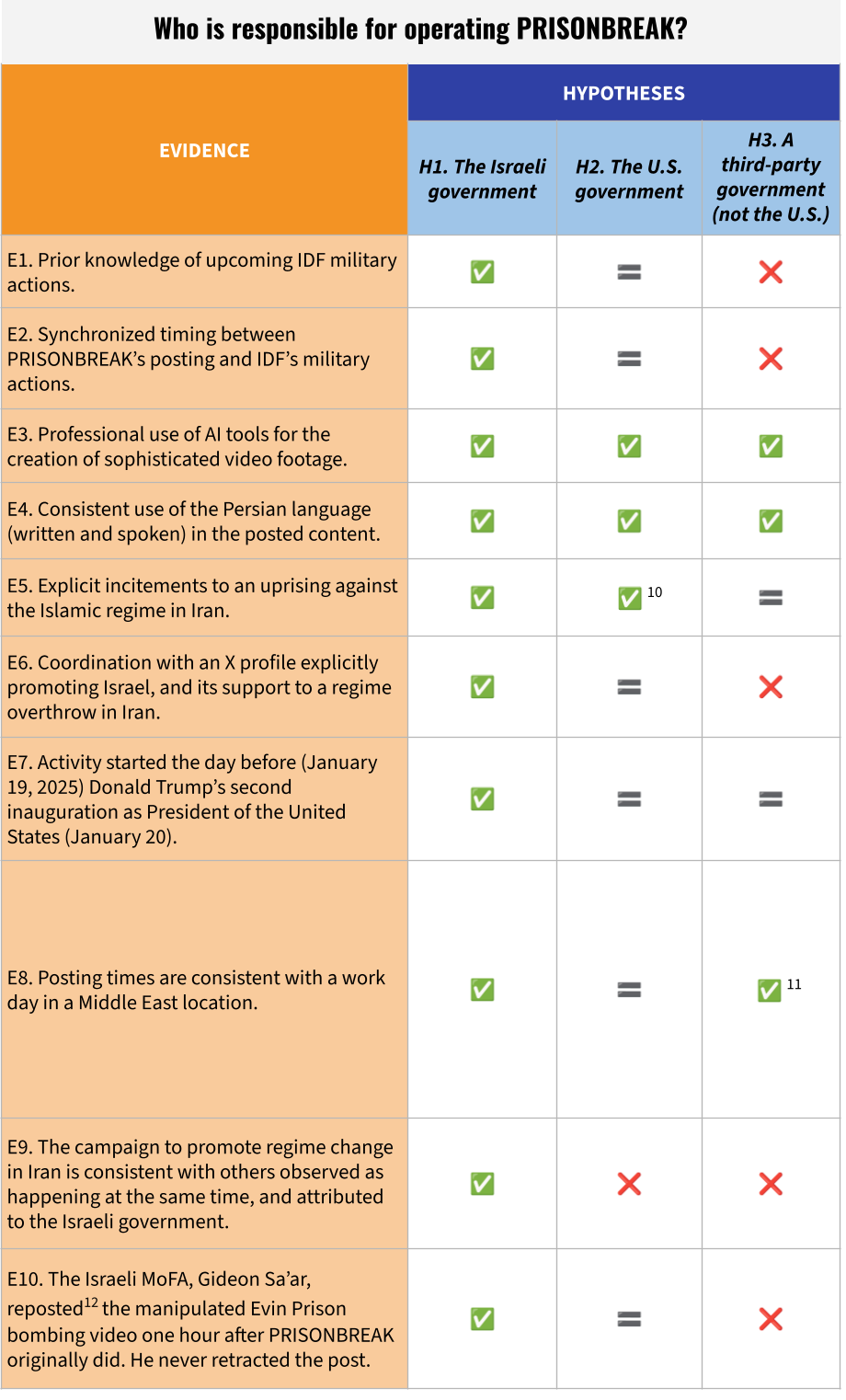
11. This is to be considered as consistent for certain governments (in the Middle East), not for others. Iran is to be excluded as the clear target of the PRISONBREAK network.
12. https://x.com/gidonsaar/status/1937083300373541216
Conclusions
Covert influence operations have been a feature of armed conflict dating back centuries, their characteristics evolving as new technologies open up opportunities for experimentation. Today, we are witnessing a new generation of covert influence operations mounted principally on and through social media and featuring the use of artificial intelligence and related digital tools and techniques. These operations benefit from the distributed nature of social media, their built-in algorithmic engagement properties (which help propel sensational content by design), as well as recent measures taken by many tech platforms to reduce the capacity of, or eliminate altogether, internal teams responsible for removing coordinated, inauthentic content. The growing sophistication and ease-of-use of AI tools has also helped power these campaigns, providing actors with an unprecedented ability to produce increasingly realistic-looking videos and images with far fewer resources than what would have been required in previous eras.
In this investigation, we have identified a coordinated network of inauthentic X profiles that, since 2023, has conducted an influence operation targeting Iranian audiences. The objective of PRISONBREAK appears to be to foster a revolt against the Iranian regime among the Iranian population. One striking feature of this campaign is its synchronization with events on the ground: the content generated by PRISONBREAK appears to have been prepared in advance of and co-timed with military strikes undertaken by the IDF in June 2025.
Although we cannot attribute this to a particular entity, the advanced preparation required and the timing of the coordinated, inauthentic posts suggests some kind of connection to the Israeli state. We believe that while it is technically possible, it is highly unlikely that any third party without advance knowledge of the IDF’s plans would have been able to prepare this content and post it in such a short window of time. Based on the data reviewed in preparing this report, the campaign we have documented was mostly likely undertaken either by an Israeli agency in-house or a private entity contracted by the Israeli government. However, without additional information we are unable to conclusively attribute the responsible parties.
While attribution around any covert operation is inherently challenging because of the steps taken by perpetrators to conceal their tracks, attribution is also made especially difficult today because social media platforms restrict access to their platforms to outside researchers, and thus to the artifacts and other details that are critical to make conclusive attribution possible. In spite of these restrictions, we were able to use a combination of qualitative and quantitative methods to conclusively determine what we were observing was not spontaneous and organic, as the perpetrators were hoping to be perceived, but rather highly coordinated and inauthentic.
However, these methods are not readily available to the general public and/or to specific target populations and typically require considerable analytical effort, time and access to special resources and data sources. Additionally, it is now generally accepted that in today’s social media environment, sensational falsehoods spread quickly and are shared widely because they feed off of human emotions and are amplified by the engagement-driven algorithms of the platforms, all of which works to the advantage of those mounting covert influence operation campaigns. These dynamics and their potentially harmful effects are exacerbated in times of political crisis and conflict, such as the military confrontation between Israel and Iran.
Notification to X
On September 30, 2025, we contacted X and provided them with the list of confirmed PRISONBREAK user accounts. At the time of publication, we had not yet received a response.
Acknowledgements
Special thanks to Alyson Bruce for editorial and graphics support, and to Siena Anstis, Rebekah Brown, and Adam Senft for review. We thank our anonymous reviewers, illustrator, and translators for their contributions.
Appendix
X Accounts
PRISONBREAK
| USERNAME | JOINED |
| ahmadsafaei789 | March 2023 |
| aliasia45 | September 2023 |
| amirhosstav | August 2023 |
| Amirifer | August 2023 |
| armantharman | September 2023 |
| Arshfrahn | August 2023 |
| azad_leylaas | September 2023 |
| DoustMehmans | August 2023 |
| Eldenminareza | April 2023 |
| Fatemehaazar | September 2023 |
| Fatemehmavi6 | March 2023 |
| fereshteh5588 | March 2023 |
| feridounazari | August 2023 |
| firoz_soltani | April 2023 |
| hadirrezvani7 | April 2023 |
| hamidshahr6 | August 2023 |
| hokaseri | April 2023 |
| iamramhei | April 2023 |
| jamsheidrezvani | April 2023 |
| kamrezi | June 2023 |
| KarNiloufar | February 2023 |
| kavehhhame | August 2023 |
| lalehfarah | March 2023 |
| leila_farhadi | December 2023 |
| leyla_zare | August 2023 |
| LeylaLeylaebra | August 2023 |
| mahjabbari | August 2023 |
| masoudffarhadi | August 2023 |
| mehdim156 | February 2023 |
| mirhoss6 | April 2023 |
| moharezjavan | September 2023 |
| nadiazazzz | September 2023 |
| Nedakkkhal | August 2023 |
| Nimassshahbaz | August 2023 |
| NPiruzi | February 2025 |
| odelia69986 | August 2023 |
| omid_hosseini2 | August 2023 |
| Parvaneh81179 | August 2023 |
| persiancat4587 | May 2023 |
| ranataabrizi | August 2023 |
| Re8Ali | August 2023 |
| royareads | April 2023 |
| sarafefee | May 2023 |
| Sepideh7895 | May 2023 |
| ShahinRmez | August 2023 |
| ShandiKeik2394 | August 2023 |
| shayanpoahm | September 2023 |
| sshahriyaresfah | August 2023 |
| vafa4587 | April 2023 |
| YasamanZamni | August 2023 |
| zahara_aminpour | September 2023 |
| Zahrashahb55 | August 2023 |
| zarabithegr8 | September 2023 |
Other Suspected Accounts
| TelAviv_Tehran | May 2025 |
Other Social Media
| URL | PLATFORM | NOTES |
| https://www.youtube.com/@%D8%AC%D9%86%DA%AF%D8%B2%D9%86%D8%AF%DA%AF%DB%8C | YouTube | YouTube channel used to post the AI-generated video of the PRISONBREAK version for the song “Baraye”. |
| https://t.me/Womens1404 | Telegram | Linked in bio by PRISONBREAK’s account @KarNiloufar |
| https://www.instagram.com/telaviv_tehran | Instagram account for the suspected X profile @TelAviv_Tehran |
Shared X Posts Between @TelAviv_Tehran and PRISONBREAK
| @TelAviv_Tehran’s post | PRISONBREAK’s post | Comment |
| https://x[.]com/TelAviv_Tehran/status/1937542242341671126 | https://x[.]com/NPiruzi/status/1937538928329801898 | AI-generated re-enactment of a famous – and often turned into a meme – scene from the movie “Der Untergang” (“Downfall”, 2004), with Ali Khamenei and apparent IRGC members replacing the characters of Adolf Hitler and Nazi top officials. |
| https://x[.]com/TelAviv_Tehran/status/1937802054040166908 | https://x[.]com/Nedakkkhal/status/1937803510533464177 | Composite of photos and videos of protests and executions of civilians in Iran, with an ending claiming that “Iran is looking forward to a brave, new leader”. |
| https://x[.]com/TelAviv_Tehran/status/1955637632215441818 | https://x[.]com/KarNiloufar/status/1955917591274229772 | AI-generated video of an alleged digital billboard “from the streets of Spain” denouncing the Iranian water crisis. The captions in the two posts are worded similarly. The AI-generated frames are overimposed on the exterior of Cine Callao, a landmark movie theater in central Madrid. |
| https://x[.]com/TelAviv_Tehran/status/1957000656906055790 | https://x[.]com/hamidshahr6/status/1958160382587261123 | AI-generated videoclip using the likeness of three existing Iranian singers for a song inciting the Iranian population to an uprising. Also hosted on YouTube. |
| https://x[.]com/TelAviv_Tehran/status/1937103753871598035 | https://x[.]com/KarNiloufar/status/1937067028885770497 | AI-generated video of the Evin Prison bombing. |
-
- See, for e.g., Jack Poulson and Lee Fang’s investigation of an international Persian-language advertising campaign directed at members of Iran’s security and intelligence agencies, nuclear scientists and their family members abroad in the apparent attempt to recruit them for Israel’s foreign intelligence service, the Mossad. In particular: “Another of the international recruitment campaigns used an image of an infant to lure viewers into a Google recruitment form which encourages Iranians to help overthrow their current government. According to Google’s ad transparency portal, the ad was last served on June 7, a week prior to the onset of the Twelve-Day War.”↩
- According to this New York Times report, in the afternoon of June 23, Iranian security forces swarmed Evin Prison, took control of the area, and transferred prisoners to different detention facilities. Prisoners were then returned to the Evin Prison in August.↩
- https://www.youtube[.]com/watch?v=FNCXszeRQYE ↩
- https://www.youtube[.]com/@%D8%AC%D9%86%DA%AF%D8%B2%D9%86%D8%AF%DA%AF%DB%8C/videos ↩
- A BBC spokesperson stated: “We urge everyone to check links and URLs to ensure they are getting news from a trusted source.”↩
- https://www.instagram[.]com/telaviv_tehran ↩
- @TelAviv_Tehran states in this post that their reporter “Sarina” is AI-generated. ↩
- This is a type of inauthentic behaviour – usually sold as a service by dedicated private firms – deployed to artificially inflate the engagement that accounts, or specific pieces of posted content, enjoy on a given social media platform. It is called differently by each platform. In its Authenticity policies, X defines it as the “inauthentic use of X engagement features to artificially impact traffic or disrupt people’s experience”.↩
- Despite President Donald Trump publicly supporting Israel’s military objectives, the U.S. government claimed not to be involved in the attacks on Iran. However on June 21, 2025, the U.S. directly attacked military targets in the country. See: “Iran’s Conflict With Israel and the United States”, Center for Preventive Action. ↩



